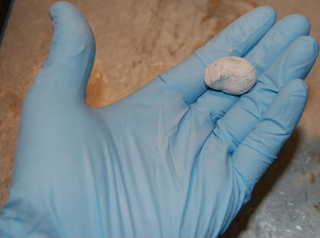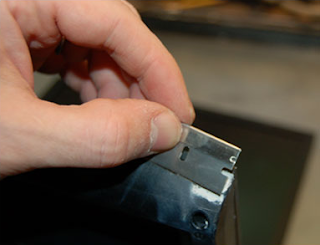A frayed power cord can be dangerous.
Because a notebook that travels needs to be plugged in and unplugged several times a day, the cord and connector can take a beating, leading to a frayed power cord. If this happens, it's important to get a new cord or fix it right away, because it not only can damage the system's battery through intermittent charging, but it can also be a fire hazard.
Fortunately, most power adapters have removable AC power cords, which cost a few dollars and are available at stores like Radio Shack. On the other hand, if the connector that plugs into the computer is the problem, it can cost $50 to $75 to replace because you have to find the exact AC adapter for your laptop from your notebook manufacturer or an online retailer .
(search for your make and model name followed by "AC adapter").
There's a quick-and-dirty repair for a frayed cord: Just roll electrical or duct tape over the damage and hope for the best. A better way is to make a more permanent repair with silicone sealant, available at any hardware store and many supermarkets, which will insulate and protect it. It's best to use black to match the cord's color, but clear sealant works just as well.
To protect the surface you're working on, lay down a wide strip of painter's tape, sticky side down, and place the frayed area of the cord on top of it. The sealant won't stick to the back of the painter's tape the way it might to other barriers made out of paper or plastic, and the painter's tape should peel right off the table when you're done. (Note, however, that you shouldn't be doing any kind of computer repairs on your good furniture.)
Next, squeeze out a gob of sealant onto the area that needs fixing. Work the gooey sealant into place, covering the damage with a liberal coating. If you have sensitive skin, it's a good idea to wear thin protective gloves for this part.
Cracked notebook case
When notebooks get dropped, more often than not they land on the corner, one of the weakest parts of the case. Unless you have a rugged notebook, there's a good chance that after an encounter with gravity, the corner will be cracked or broken through completely.
 |
| An unfortunate encounter with gravity caused this hole. |
The secret is to use epoxy putty to fill in the broken part of the case. Epoxy putty is available online or at any hardware store for around $4 to $6 a tube, so you can even do this repair on the road. The brand of putty you choose doesn't matter, but avoid the quick-setting variety because it might harden before you're done.
First, make sure the damaged area is clean and free of dirt and loose pieces.
Then it's time to prepare the putty. It comes as a cylinder with two components wrapped around each other. Just cut a section off and twist the parts together.
 |
| Mix the two putty components completely. |
The key to a smooth case repair is to thoroughly mix the two components together in your hands. Because the putty hardens as the result of a chemical reaction between the two parts, it's important that they are completely blended together. You might want to use gloves for this part because some people are sensitive to the chemicals in the putty.
Try rolling the putty into a long cylinder and then folding it over itself several times. After a few minutes, the putty becomes a uniform white or gray and you're ready.
You'll feel like a kid working with Play-Doh, and in fact, the putty should be the consistency of Play-Doh, which is perfect for working it into the damaged area. Press it firmly into the hole in the case and use your finger or a razor blade to shape it to follow the contour of the case. When it covers the area, take the flat side of a razor blade or back of a ruler and compress the outer surface to flatten it. Any excess putty can be wiped off the case with paper towel before it dries.
When you like the way it looks, go do something else for an hour or two until the epoxy is cured. When it has hardened, the epoxy patch is just as strong as the plastic case.
 |
| Press the putty into the damaged area and flatten the outer surface. |
 |
| I smooth the epoxy with a razor blade. |
I smooth the epoxy with a razor blade and then 220-grit sandpaper. Then I give it a final sanding with 2,000-grit paper that is slightly wet to remove any surface scratches.
Naturally, the color doesn't match. If it's a small repair, try using a Sharpie marker to cover it up.
Or you can use model airplane enamel paint, which costs about $5 for a small bottle; a full set of colors with brushes is $10. When it's dry, the repair is done and can only be seen if you look closely.
The final (optional) steps are sanding the dried patch with increasingly finer sandpaper and painting it to match the case.
By Brian Nadel READ MORE:



























No comments:
Post a Comment